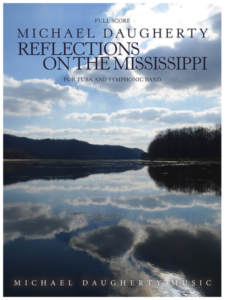Reflections on the Mississippi
for tuba and symphonic band (2015)
I. Mist
II. Fury
III. Prayer
IV. Steamboat
Instrumentation: Piccolo, 2 Flutes, 2 Oboes, English Horn, 4 Bb Clarinets, Bb Bass Clarinet, Bb Contrabass Clarinet, 2 Bassoons, Contrabassoon, Soprano Saxophone, Alto Saxophone, Tenor Saxophone, Baritone Saxophone, 4 Horns, 3 C Trumpets, 3 Trombones, 2 Euphoniums, Solo Tuba, Timpani (Four drums; 32” 29” 26” 23″), Percussion (3 Players; instruments are not shared): 1. Glockenspiel, Crotales (D, F, A, C), Xylophone, Small Tambourine, Vibraslap, Mark Tree; 2. Vibraphone, Suspended Cymbal, Washboard, Woodblock, Bell Tree, Whip; 3. Marimba (4 octaves), Snare Drum, Kick Drum, Castanets, Triangle, Chimes, Concert Bass Drum, Vibraslap; Piano, Contrabass (1 or 2 players, 2 preferred)
Publisher: Michael Daugherty Music
Duration: 22 minutes
World Premiere: Reflections on the Mississippi (2015) for Tuba and Symphonic Band was commissioned by the University of Michigan Symphony Band, Michael Haithcock, music director. The world premiere was given by the University of Michigan Symphony Band under the direction of Michael Haithcock, with Carol Jantsch, solo tuba, at Hill Auditorium, Ann Arbor, Michigan on February 6, 2015.

Program Note:
This concerto, composed in memory of my father, Willis Daugherty (1929-2011), is a musical reflection on family trips during my childhood to the Mississippi River near McGregor, Iowa. In July and October 2012, I returned to the Mississippi to make two road trips from McGregor to Hannibal, Missouri. Along the Great River Road I explored small river towns and snapped photographs of scenic river vistas. Local boat owners also guided me to the secluded wildlife havens and murky backwaters of the Mississippi River. All the while, I was collecting sounds, musical ideas and an emotional framework for my tuba concerto.
In the first movement of the concerto, “Mist,” I reflect on sunrise as seen and heard through a misty haze over the Mississippi River. After an opening ripple, the tuba intones a mystical melody that ascends through shimmering chords. An ostinato is introduced in a musical canon by percussion, piano and tuba, followed by a dark second theme that rises from the depths of the brass section punctuated by woodwinds. At the end of the movement, the ostinato returns in the timpani and is combined with the misty opening melody of the tuba.
The title of the second movement, “Fury,” recalls the turmoil of the Mississippi River in the fiction of William Faulkner and in the history of the Great Mississippi Flood of 1927. Like the jarring time shifts in Faulkner’s 1927 novel, The Sound and the Fury, the music I have created consists of dissonant harmonies, turbulent polyrhythms, and clashing 3/4 and 5/4 time signatures performed simultaneously.
In “Prayer,” the third movement, I meditate on the calm mood of the Mississippi River seen from a high vista, overlooking the water as far as the eye can see, as sunset turns into a clear and starry night. Glockenspiel, vibraphone, chimes and piano echo like distant church bells down in the valley, while the tuba plays a lyrical, soulful melody. In a musical flashback, I evoke material from the first movement to remind us of the timeless currents of the Mississippi River.
The final movement, “Steamboat,” conjures up colorful tales from Life on the Mississippi by Mark Twain (1835-1910). Traveling down the Mississippi River, I have composed lively music that follows the gambling steamboats from Twain’s hometown in Hannibal, Missouri, to the final stop in New Orleans. Much as the tuba plays a central role in Zydeco and Second line music of New Orleans, the tuba soloist in my concerto leads a second line of syncopated rhythms that propel the concerto to a virtuosic conclusion.
–Michael Daugherty
